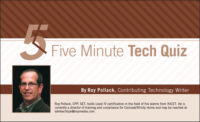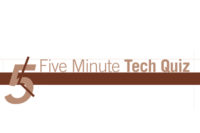ANSWERS BELOW.
- Magnetic locks require a request-to-exit device.
- True
- False
- An electric lock that requires power to unlock is called:
- fail-safe.
- fail-secure.
- anti-passback.
- Any of the above
- None of the above
- An electric lock that requires power to lock is called:
- fail-safe.
- fail-secure.
- anti-passback.
- Any of the above
- None of the above
- Which of the following is an example of biometrics?
- Finger reader
- Retina scan
- Iris scan
- Hand geometry above
- All of the above
- All 24-volt DC electric locks require the same amount of current.
- True
- False
- What type of jack is used to connect an access control system to an Ethernet-based LAN?
- RJ-11
- RJ-38X
- RJ-45
- Any of the above
- Shear magnetic locks cannot be recessed.
- True
- False
- In order to utilize anti-pass back, you must use in-and-out readers.
- True
- False
- What gauge of wire should be run to a 24-volt electric lock?
- 18
- 16
- 14
- It varies
- DC-powered electric locks can be powered from an AC source by adding a rectifier.
- True
- False
- Which of the following features are available with access control systems?
- Integration to DVR
- LAN/WAN connectivity
- Integration to building automation systems
- Integration to fire alarm systems
- All of the above
- You should only run Cat 5 cable to all readers.
- True
- False
- The fire alarm system should be interconnected to the access control system.
- True
- False
- Door status switches are often used for door held/forced events.
- True
- False
- Which of the following can be used to grant or deny access?
- Time of day
- Door reader
- Day of week
- All of the above
- None of the above

What’s Wrong with This?
Wally `Larman installed a four-door access control system using four 24-volt 500ma DC fail-safe electric locks. Wally installed the proper cable, connecting the locks as shown in this diagram, and programmed the system to meet his client’s needs. When tested, the system performed as required, but the next day the client called and told Wally that all the doors were unlocked. When Wally arrived, he found the fuse in the lock power supply blown, so he tested each lock and cable but was unable to determine the cause of the problem. Can you see what Wally did wrong and what he must do to correct the problem?5-Minute Tech Quiz Answers
Here are the answers to the 5-Minute Tech Quiz and What’s Wrong with This? that appears on Page 49.- a – Unlike electric locks or strikes which can have easy egress door hardware, magnetic locks must have some type of device to release the lock for exit.
- b.
- a – Locks that are unlocked without power are called fail-safe, because it is unlocked during a power outage.
- e.
- b – The current draw of an electric lock depends upon many factors. To determine how much power a given lock requires, you should read the lock’s specifications.
- d.
- b – Unlike standard magnetic locks, shear locks are designed to be mortised into the frame and door.
- a – Since anti-passback prevents re-entry into an area without leaving, in-and-out readers must be used.
- d – The gauge of wire used depends upon many factors, such as the current draw of the lock, the voltage and the length of the cable. All of these factors must be taken into account when designing the system.
- a – Because a rectifier converts AC power to DC, you can use a rectifier to power a DC lock from an AC source.
- e
- b – The cable required depends upon the type of reader used. Check with your supplier to determine which cable must be run.
- a
- a
- d – Any or all of the events can be used to allow or deny access


